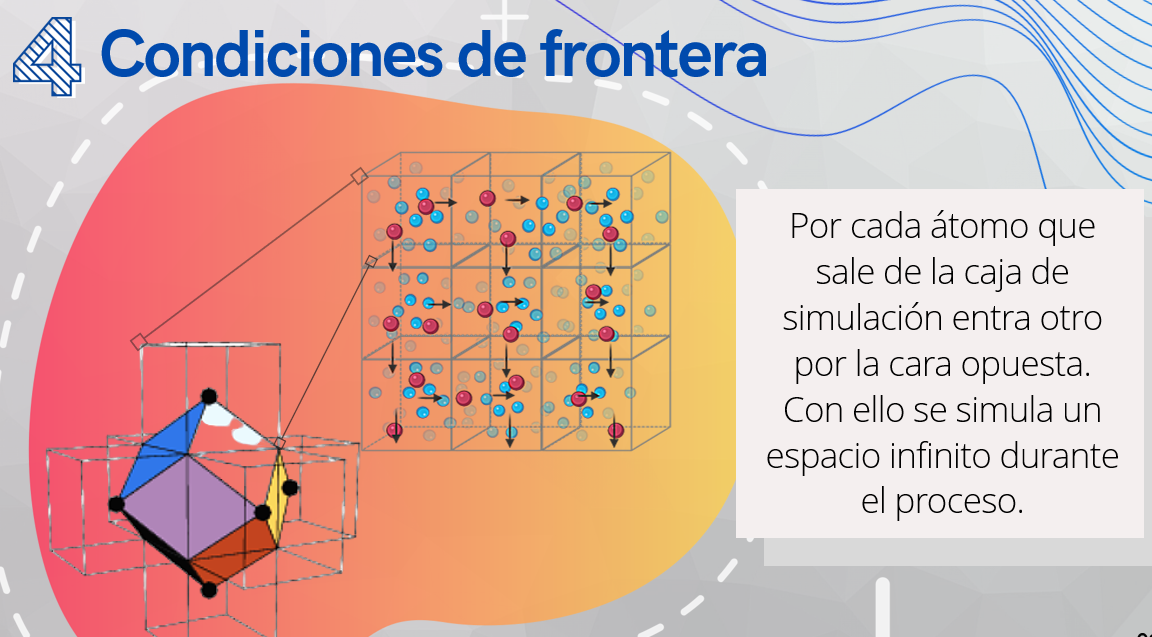Bienvenido,
Si lo que quieres es entender un poco mejor el proceso de dinámica molecular clásica orientado a biomoléculas... ¡Llegaste al lugar adecuado! Vamos a resumir los pasos y etapas involucradas en este proceso.
Comencemos con entender ¿Qué es la dinámica molecular clásica?
Ahora explicaremos el proceso paso por paso:
PREPARACIÓN DEL SISTEMA
1. Existen varios ensambles estadísticos que se pueden emplear en los sistemas. Wereszczynski y McCammon, 2012 los definen como una colección de varios microestados de un sistema macroscópico en equilibrio según lo determinado por las restricciones que operan en dicho sistema. Frecuentemente las simulaciones en condiciones fisiológicas de los organismos vivos se llevan a cabo bajo condiciones de N, V, T, p y u constantes, y es por esa razón que se utilizan en el modelado biomolecular.
- AMBER (Assisted Model Building and Energy Refinement)
- CHARMM (Chemistry at HARvard Molecular Mechanics) GROMOS (GROningen MOlecular Simulation package)
- OPLS (Optimized Potential for Liquid Simulations
- Cifra, M., Průša, J., Havelka, D., & Krivosudský, O. (2018). Water models in molecular dynamics simulation prediction of dielectric properties of biomaterials. IEEE Journal of Electromagnetics, RF and Microwaves in Medicine and Biology, 3(2), 97-104. https://doi.org/10.1109/JERM.2018.2878379
- Gerrard, J.A. and Domigan, L.J. eds., 2020. Protein nanotechnology: protocols, instrumentation, and applications. (3rd ed). Humana Press. https://doi.org/10.1007/978-1-4939-9869-2
- Gupta, S., & Varadwaj, P. K. (2018). A Brief overview on molecular dynamics simulation of biomolecular system: procedure, algorithms and applications. International
- journal of pharmaceutical sciences and research, 9(4), 1333-1350.
- Hollingsworth, S.A. and Dror, R.O., 2018. Molecular dynamics simulation for all. Neuron, 99(6), pp.1129-1143. https://doi.org/10.1016/j.neuron.2018.08.011
- Lopes, P. E., Guvench, O., & MacKerell, A. D. (2015). Current status of protein force fields for molecular dynamics simulations. In Molecular modeling of proteins (pp. 47-71). Humana Press, New York, NY. https://doi.org/10.1007/978-1-4939-1465-4_3
- Roy, K., Kar, S., & Das, R. N. (2015). Understanding the basics of QSAR for applications in pharmaceutical sciences and risk assessment. Academic
- press. https://doi.org/10.1016/B978-0-12-801505-6.00005-3
- Schneider, R., Sharma, A. R., & Rai, A. (2008). Introduction to Molecular Dynamics. In Computational Many-Particle Physics (pp. 3-40). Springer, Berlin, Heidelberg.
- Selzer, P.M., Marhöfer, R.J. and Rohwer, A., 2018. Applied bioinformatics. An introduction. Springer, Verlag, Berlin, Heidelberg, Germany, 260.
- UCSF Computer Graphics Laboratory. 2020. Introduction to Protein Data Bank Format. https://www.cgl.ucsf.edu/chimera/docs/UsersGuide/tutorials/pdbintro.html
- Wereszczynski, J. and McCammon, J.A., 2012. Statistical mechanics and molecular dynamics in evaluating thermodynamic properties of biomolecular recognition. Quarterly reviews of biophysics, 45(1), p.1. https://doi.org/10.1017/S0033583511000096
- Widom, B. and Widom, B., 2002. Statistical mechanics: a concise introduction for chemists. Cambridge University Press. http://assets.cambridge.org/97805218/11194/excerpt/9780521811194_excerpt.pdf








Gracias por compartir tus conocimientos :-D
ResponderEliminar